Document 10518352
advertisement
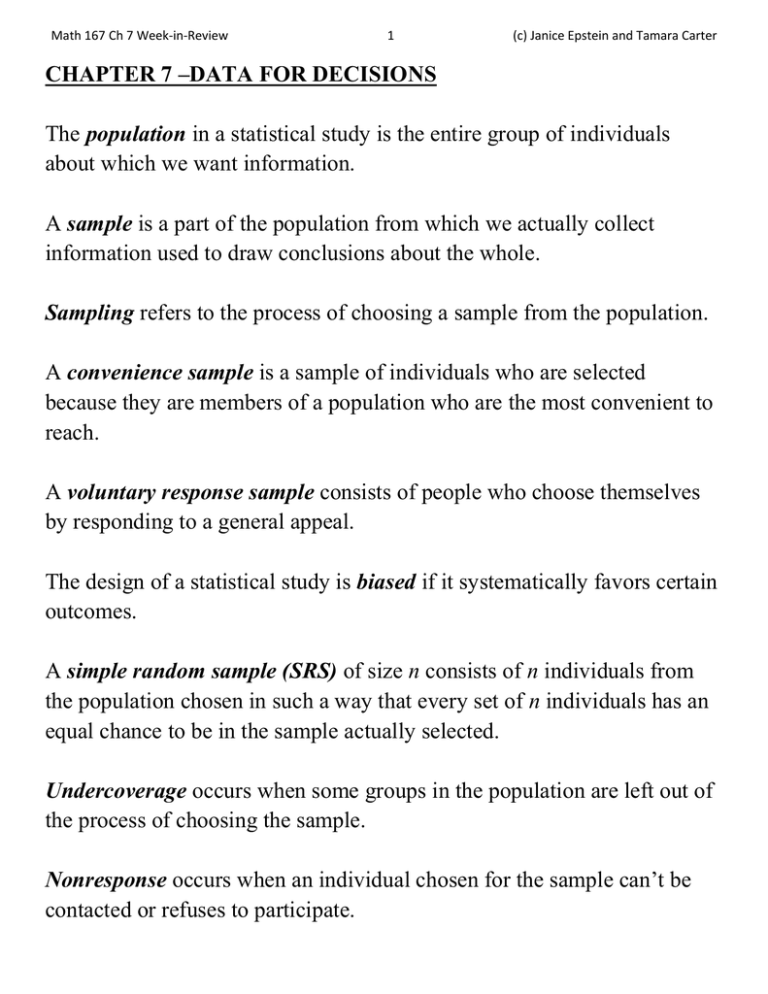
Math 167 Ch 7 Week-in-Review 1 (c) Janice Epstein and Tamara Carter CHAPTER 7 –DATA FOR DECISIONS The population in a statistical study is the entire group of individuals about which we want information. A sample is a part of the population from which we actually collect information used to draw conclusions about the whole. Sampling refers to the process of choosing a sample from the population. A convenience sample is a sample of individuals who are selected because they are members of a population who are the most convenient to reach. A voluntary response sample consists of people who choose themselves by responding to a general appeal. The design of a statistical study is biased if it systematically favors certain outcomes. A simple random sample (SRS) of size n consists of n individuals from the population chosen in such a way that every set of n individuals has an equal chance to be in the sample actually selected. Undercoverage occurs when some groups in the population are left out of the process of choosing the sample. Nonresponse occurs when an individual chosen for the sample can’t be contacted or refuses to participate. Math 167 Ch 7 Week-in-Review 2 (c) Janice Epstein and Tamara Carter A polling company surveys 200 people outside a county courthouse concerning tighter restrictions on smoking in public buildings in the county. (a) What is the population? (b) What is the sample? (c) Is this a SRS? (d) What type of bias may be present? To determine the proportion of voters who favor a certain candidate for governor, the campaign staff phones 2500 residents of the state chosen from the state property tax rolls. (a) What is the population? (b) What is the sample? (c) Is this a SRS? (d) What type of bias may be present? Math 167 Ch 7 Week-in-Review 3 (c) Janice Epstein and Tamara Carter In order to determine the proportion of voters in a small town who favor a candidate for mayor, the campaign staff takes out an ad in the paper asking voters to call in their preference for mayor. (a) What is the population? (b) What is the sample? (c) Is this a SRS? (d) What type of bias may be present? A polling company conducted a survey of voters to obtain data for a political campaign. They selected 3500 voters randomly from the 16,800 names on the voter registration lists of the county. Each voter contacted can reply by mail, phone or internet. (a) What is the population? (b) What is the sample? (c) Is this a SRS? (d) What type of bias may be present? Math 167 Ch 7 Week-in-Review 4 (c) Janice Epstein and Tamara Carter How can we choose a SRS? Use a table of random digits. A table of random digits is a list of the digits 0, 1, 2, 3, 4, 5, 6, 7, 8, 9 with the following two properties: Each entry in the table is equally likely to be any of the 10 digits 0 through 9 The entries in the table are independent of each other. To use the table of random digits to generate a SRS, do the following: 1. Give each member of the population a numerical label of the same length. 2. Read from the table strings of digits of the same length as the labels. 3. Skip values that are not in the range. 4. Ignore spaces and don’t carry numbers over from the previous line A group of people want to order random items off a menu with 40 different items. How will the items be labeled? Which items will be chosen if the group wants 4 items? Start at line 102. Will the items chosen change if the items are labeled differently? LINE 101 102 103 104 105 106 08705 00755 35486 87788 51052 88988 RANDOM DIGITS 42934 79257 89138 39242 50772 44036 59500 20060 89769 73717 19287 69954 25648 02523 84300 12439 73741 30492 21506 54518 54870 45917 83093 19280 26797 56865 75586 80026 39852 41255 Math 167 Ch 7 Week-in-Review 5 (c) Janice Epstein and Tamara Carter If a business has 4,490 employees, how could they be assigned labels? Choose four employees from the table of random digits below starting at line 122. 120 121 122 123 124 125 126 127 128 129 130 2 3 3 9 4 8 5 7 9 0 2 7 5 2 7 0 7 1 0 0 0 7 0 1 2 8 1 5 3 7 2 9 2 3 8 7 8 3 3 4 1 3 6 1 1 6 4 6 5 8 9 8 4 2 9 0 0 6 3 2 7 3 4 7 9 6 3 3 7 1 2 4 9 0 4 3 7 8 9 4 4 6 6 8 9 9 9 2 9 5 9 8 0 3 8 4 8 5 6 7 1 2 0 9 3 5 1 3 8 0 1 6 2 9 7 4 2 2 3 4 8 6 8 1 6 1 0 9 8 7 6 2 7 2 6 6 8 0 9 7 7 9 7 3 0 2 1 7 0 9 0 3 8 4 8 8 5 1 5 2 5 6 2 5 0 3 7 3 3 7 7 3 7 3 9 1 1 3 0 9 3 4 7 5 7 4 8 4 4 2 0 4 4 8 5 0 9 9 5 6 9 3 3 7 5 1 2 8 4 3 0 8 1 3 9 8 0 4 9 6 0 7 1 3 1 8 1 0 4 3 2 7 5 5 1 2 8 8 5 1 0 9 5 3 8 5 8 1 3 8 7 2 1 4 1 5 2 3 1 1 3 1 2 7 5 4 5 5 8 3 3 2 8 1 0 Math 167 Ch 7 Week-in-Review 6 (c) Janice Epstein and Tamara Carter An experiment deliberately imposes a treatment on individuals in order to observe their responses. The purpose of an experiment is to study whether the treatment causes a change in the response. Variables are said to be confounded when their effects on the outcome cannot be distinguished from each other. How can we deal with confounded variables? Use a control group that does not receive the treatment. A controlled experiment is an experiment that has a control group. An uncontrolled experiment is an experiment that lacks a control group. The placebo effect is the effect of a dummy treatment on the response of the subjects. In a double-blind experiment neither the experimental subjects nor the observers know which treatment the subjects are given. An observed effect so large that it would rarely (less than 5% of the time) occur by chance is called statistically significant. An observational study is a passive study of a variable of interest. The study does not attempt to influence the responses and is meant to describe a group or situation. A prospective study is an observational study that records slowly developing effects of a group of subjects over a long period of time. A retrospective study is an observational study that uses interviews or records to collect information about past behaviors in two or more groups. Math 167 Ch 7 Week-in-Review 7 (c) Janice Epstein and Tamara Carter A group of 200 students is identified. Half took Latin in high school and half did not. The students are compared to see if the students who took Latin received higher SAT verbal scores. Was this a study or experiment? A group of people with high blood pressure were given a magnesium supplement or a placebo for 4 weeks. The two groups are compared to see if the magnesium supplement lowered blood pressure. Was this a study or an experiment? A group of adults were asked if they drank fluoridated water when they were young and asked how many dental fillings or crowns they have. Was this a study or an experiment? If you wanted to know how smoking affects a baby’s birth weight, would you do an experiment or a study? Statistical inference refers to methods used for drawing conclusions about an entire population on the basis of data from a sample. A confidence interval is one type of inference method. Statistical inference will only be valid if the data is from a random sample or a randomized comparative experiment. A parameter is a fixed (and usually unknown) number that describes a population. A statistic is a number that describes a sample. Math 167 Ch 7 Week-in-Review 8 (c) Janice Epstein and Tamara Carter If the parameter for the proportion of successes is called p, then the corresponding statistic for the proportion of successes is called p̂ . An opinion poll uses random digit dialing to dial 300 phone numbers in an area code. There were 72 cell numbers dialed which is not surprising as 25% of the numbers in that area code are cell phone numbers. The number 72/300 is The number 25% is An online poll asks if you had been to a movie at a theater in the last week. This poll had 450 responses, and 200 of them were positive. However, the information from the local theaters indicates that 20% of the residents go to a theater each week. What are p and p̂ ? The sampling distribution of a statistic is the distribution of values taken on by the statistic in all possible samples of the same size from the same population. At a certain school 60% of the students are football fans. A SRS of 50 students are chosen and asked if they like football. The result was 31 students liked football (31/50 = 0.62 = 62%). A different SRS of 50 students was chosen and that survey found 27 students liked football (27/50 = 54%). The next few results were 33 students (66%), 29 students (58%), and 34 students (64%). Math 167 Ch 7 Week-in-Review 9 (c) Janice Epstein and Tamara Carter The results of the 40 surveys done are shown. The mean result of the 40 surveys was 30.6 and a standard deviation of 3.5. When a SRS of size n is chosen from a large population that has a proportion of success p. The shape of the sampling distribution of p̂ will be approximately normal if n is 30 or more. The mean of the sampling distribution of p̂ is p. The spread in the sampling distribution of p̂ is p(1 p) n The margin of error in a sampling distribution at 95% confidence is 2 p(1 p) n Math 167 Ch 7 Week-in-Review 10 (c) Janice Epstein and Tamara Carter With our population p = 0.6 and SRS of size n = 50, what do we expect the sampling distribution to look like? What is the margin of error (at 95% confidence level)? Between what two values should 95% of our results fall? Between what two values should 99.7% of our results fall? Math 167 Ch 7 Week-in-Review 11 (c) Janice Epstein and Tamara Carter A population has a 20% chance that a adult reads a newspaper. A SRS of 100 adults were asked if they read the newspaper. If this experiment was repeated many times, what would the sampling distribution look like? How large would the sample need to be to have a margin of error of 3% at a 95% confidence level? Math 167 Ch 7 Week-in-Review 12 (c) Janice Epstein and Tamara Carter SAMPLE EXAM QUESTIONS FROM CHAPTER 7 1. An opinion poll selected 500 email addresses at random from a list of 2500 student emails. Of these, 111 are freshmen. This is not surprising because 25% of the students are freshmen. Which number or numbers below are parameters? (A) no values are parameters (B) 111/500 (C) 500/2500 (D) 25% 2. You wish to survey the students at your college to determine their feelings about the quality of services in the student center. Which of the following sampling designs is best for avoiding bias? (A) Air an announcement on the campus radio station asking all listeners to phone in their opinions. (B) Survey every tenth student who enters the student center. (C) Place an ad in the student newspaper asking all readers to mail in their opinions. (D) Obtain a list of student names from the registrar and select 250 names to contact. 3. In order to determine the mean weight of bags of chips filled by its packing machines, a company inspects 50 bags per day and weighs them. In this example, the population is: (A) the 50 bags inspected each day. (B) all potato chips produced by the company. (C) all bags of chips produced by the company. (D) the weight of the 50 bags inspected. Math 167 Ch 7 Week-in-Review 13 (c) Janice Epstein and Tamara Carter 4. To determine the proportion of students at a university who favor the construction of a parking garage, a student senate member surveys students as they leave the student union. This type of sample is a: (A) convenience sample. (B) simple random sample. (C) voluntary response sample. 5. Consider the following situation: A group of 300 students is randomly selected at a local high school and required to fill out yearly questionnaires on family income. Students' performances on standardized tests are then followed throughout their high school years to determine if socioeconomic status affects test scores. This describes (A) a comparative experiment. (B) a controlled experiment. (C) a prospective study. (D) a retrospective study. 6. A dummy medication (such as a salt tablet) will often help a patient who trusts the doctor who administers the medicine. This is called: (A) confidentiality. (B) double-blindness. (C) confounding variables. (D) the placebo effect. 7. A flashlight manufacturer sets aside a production line for the assembly of 2000 flashlights to fill a special order. Ninety of these flashlights are selected at random from the production line to be tested, and 15 are found to be defective. The population is: (A) the 15 defective flashlights. (B) the 90 flashlights tested. (C) the 2000 flashlights produced for this order. (D) all flashlights produced by the manufacturer. (E) None of these Math 167 Ch 7 Week-in-Review 14 (c) Janice Epstein and Tamara Carter 8. If the 95% confidence interval is determined to be from 56% to 62%, then the standard deviation is (A) 6% (B) 3% (C) 1.5% (D) 12% (E) None of these 9. You must choose a simple random sample of 25 of the 314 members of your fly fishing club. How would you label the population in order to use a table of random digits to make your selection? (A) 1, 2, 3, …, 24, 25 (B) 1, 2, 3, …, 313, 314 (C) 000, 001, 002, …, 313, 314 (D) 001, 002, 003, …, 313, 314 (E) None of these 10. In opinion poll of 1000 adults, 35% said they thought the weather was good. What is the margin of error in this poll at a 95% confidence level? (A) 0.0151 (B) 0.0302 (C) 0.00023 (D) 0.00046 (E) none of these Math 167 Ch 7 Week-in-Review 15 (c) Janice Epstein and Tamara Carter 11. Raffle tickets are issued with the numbers 1001 to 3003 on them. Three prizes will be given out using the table of random digits below. Starting on line 112, which raffle tickets are winners? 110 8 2 0 2 8 4 3 1 1 7 2 6 5 6 8 9 4 1 4 3 8 8 4 9 9 8 0 6 8 3 111 4 6 2 7 9 9 4 5 5 1 0 2 2 3 8 2 0 7 7 0 6 6 2 4 0 0 7 7 0 9 112 4 0 8 8 6 0 9 4 8 1 8 2 1 2 6 7 1 8 8 0 6 8 2 2 9 0 3 0 4 9 113 1 5 0 1 4 4 1 3 8 2 5 6 0 9 4 3 8 3 9 7 5 0 4 2 1 6 1 2 0 2 114 0 9 3 3 3 3 8 4 9 5 5 2 5 6 1 5 1 6 1 8 2 6 3 8 7 7 7 2 1 4 115 3 4 7 7 6 1 4 7 6 2 0 8 6 4 3 2 2 8 4 9 0 5 8 8 9 4 6 8 6 9 116 1 5 4 6 9 3 5 3 2 1 1 1 1 7 9 8 1 8 9 5 3 4 0 7 4 4 2 6 5 0 117 3 1 6 6 7 1 2 8 3 2 7 5 7 1 9 5 5 3 6 6 4 3 8 2 9 3 2 4 5 5 118 8 9 3 3 5 3 1 5 8 2 3 9 5 3 1 3 5 8 8 1 3 7 7 3 6 2 2 5 4 2 1st ticket is ________ 2nd ticket is ________ 3rd ticket is _________ 12. A pollster wants to have a margin of error of 2% in his poll at a 95% confidence level. If p = 0.4, how large does the sample need to be?

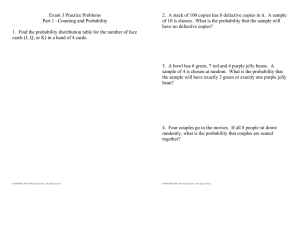
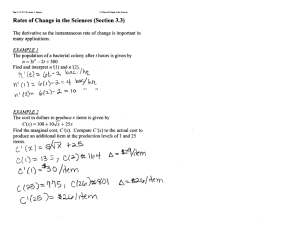
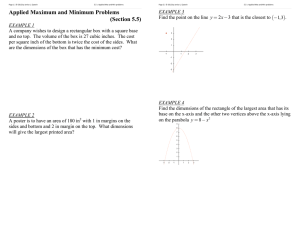
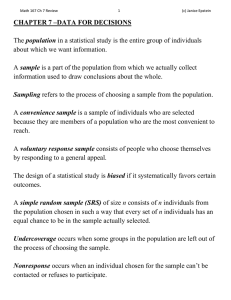

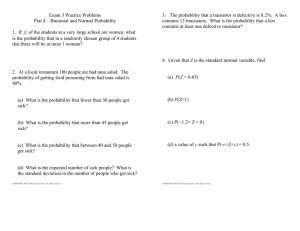

![Area (Section 6.2) [ ]](http://s2.studylib.net/store/data/010413671_1-efe902d3637e0ae3939f101c43978461-300x300.png)
